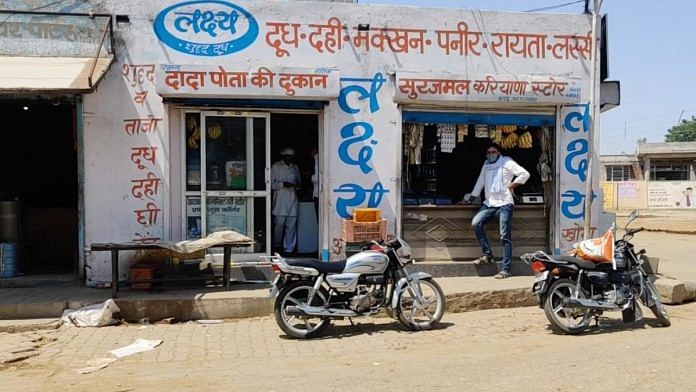Gurugram: Haryana witnessed the second-highest inflation rate in the country this September, according to official data released last week. This has led to a fresh war of words between the BJP-led state government and its opponents over what is driving the rise in prices.
While officials in the Chief Minister’s Office (CMO) say the inflation is a reflection of the higher purchasing power of the state’s residents, the government’s critics say it’s simply evidence of its mismanagement.
Economists, meanwhile, attribute this high inflation to food prices and the poor penetration of Haryana’s supply chain networks.
The National Statistical Office’s (NSO) data on the Consumer Price Index (CPI) for September 2023 showed Haryana had a retail inflation rate of 6.49 percent, compared to the national inflation rate of 5.02 percent. Rajasthan was the only state with higher inflation, at 6.53 percent.
Among Haryana’s other neighbouring states, Punjab reported an inflation rate of 5.48 percent, Uttar Pradesh of 5.45 percent, and Himachal Pradesh of 5.12 percent. Delhi saw an inflation rate of 2.24 percent, the second lowest in the country after Chhattisgarh.
Also Read: Haryana losing sheen for industry? Why state was ranked among bottom 5 by RBI in key economic metric
Playing politics over prices
Taking a dig at the BJP-JJP government on the high inflation figures, Congress leader and former Haryana chief minister Bhupinder Singh Hooda said that the government has proved a failure on all fronts.
“When the Congress was in power in the state, Haryana was considered first in the matter of per capita income, per capita investment, and several other fields,” he told ThePrint. “But now, it’s racing for the top position in all negative things.”
“Today, Haryana is number one in unemployment, number one in crimes, number one in drugs and now, number one in inflation too,” Hooda added.
The Haryana government, however, has claimed that the high inflation rate is a reflection of higher consumption in the state’s economy.
Jawahar Yadav, officer on special duty (OSD) to Haryana Chief Minister Manohar Lal Khattar, said that the inflation rate in the state is high because people here have relatively better purchasing power.
“Ours is a state with one of the best per capita incomes in the country,” Yadav told ThePrint. “When people have more money to buy food items and other commodities, it’s bound to reflect in the inflation rate.”
Ministry of Statistics data shows Haryana had the 7th highest per capita income level in 2021-22, of Rs 2.64 lakh, at current prices. While the data is not complete for all states for 2022-23, therefore disallowing a ranking comparison, Haryana’s per capita income grew to Rs 2.96 lakh that year.
Neighbouring Delhi, notably, had a per capita income at current prices of Rs 3.89 lakh in 2021-22, nearly 50 percent higher than that of Haryana that year.
Yadav, however, said that comparing Haryana with Delhi was not a wise idea because a very large number of people in the national capital live in poverty.
Food at the root
Food prices experienced higher inflation, going by the NSO data, compared to the general Consumer Price Index (CPI), said Dr. Ashok Kumar Chauhan, a professor in economics at Kurukshetra University.
“This suggests that the cost of food items has been increasing at a faster rate than the overall inflation rate, potentially impacting the affordability and purchasing power of consumers,” he added.
Professor NK Bishnoi, an economist at Guru Jambheshwar University of Science and Technology, noted that the persistent issue of food prices driving inflation in Haryana is linked to the state’s culinary preferences.
Haryana, like Rajasthan, is “largely a vegetarian state”, and thus experiences higher prices for vegetables, pulses, and cereals, which contribute to the overall inflation rate, he said.
According to the government’s figures, the inflation rate for the month of September 2023 is 10.95 percent for cereals and products, 16.38 percent for pulses and products, 7.3 percent for fruits, and 23.06 percent for spices.
However, this is an all-India phenomenon and not restricted to Haryana. The difference seems to be the state of Haryana’s supply chains.
What makes Haryana different
Low urbanisation and the absence of supermarkets in most of Haryana’s towns are major contributors to the region’s inefficient supply chain, said Abhay Singh Godara, a professor in economics at Chaudhary Devi Lal University, Sirsa. These factors, he noted, have a direct impact on inflation.
“Leaving aside Gurugram, Faridabad and Panchkula, we don’t have a single town in Haryana that looks like a city,” Godara explained. “Compare our towns with those of Punjab and you will see the difference.”
Bishnoi also agreed with the assessment of the poor state of Haryana’s supply chains, saying that the reason Delhi had a much lower inflation rate was because of the efficiency of its supply chains.
Expanding on this, Godara said that while supermarkets like Easyday and Reliance Fresh did open outlets in most towns of Haryana, many ended up shutting due to meagre footfall.
“The general mindset of people in smaller towns is to purchase vegetables and grocery items from shops and vendors where they have the luxury of bargaining and getting goods on credit,” Godara said.
Another factor, he said, was the agrarian nature of society in Haryana: “Many people, particularly from an agriculture background, keep purchasing food items on credit and clear the bills only twice in a year when their crops are sold.”
(Edited by Asavari Singh)
Also Read: Poultry and chicken keep food inflation low. Time India’s policymakers promoted it



